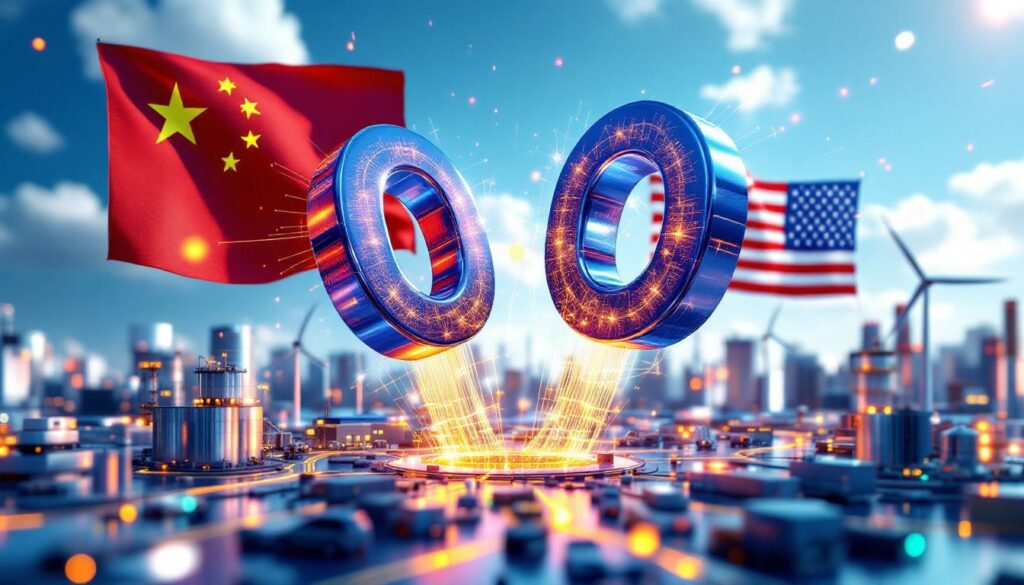China's Rare Earth Magnet Exports to US: June 2025 Surge Analysis
China's exports of rare earth magnets to the United States experienced a remarkable 660% increase in June 2025 compared to May, reaching 353 metric tons according to data from China's General Administration of Customs. This dramatic recovery follows several months of severely restricted trade after China implemented export controls in early April 2025. The surge signals a potential normalization in the supply chain for these critical minerals that are essential components in electric vehicles, wind turbines, and numerous high-tech applications.
The June recovery came after bilateral trade agreements between the two economic powers that specifically addressed issues surrounding rare earth minerals and magnets. While still below historical levels, this export resurgence represents a critical turning point in the US‑China trade impact between the world's two largest economies.
Key Export Statistics and Timeline
The export data reveals a dramatic fluctuation in rare earth magnet trade throughout 2025:
- June 2025: 353 metric tons to US (660% increase from May)
- April-May 2025: Sharp decline due to newly implemented export license requirements
- First half of 2025: Overall 18.9% year-on-year decline to 22,319 tons globally
- June 2025 global exports: 3,188 tons (157.5% increase from May, but still 38.1% lower than June 2024)
Industry analysts project that "shipments of magnets are likely to recover further in July as more exporters obtained licenses in June," according to Reuters reporting, suggesting the beginning of a sustained recovery period.
Market Significance of the Surge
The June export increase represents far more than just a statistical anomaly. It signals:
- Critical recovery in strategic mineral trade after months of disruption
- Potential normalization of Sino-US trade relations in high-tech materials
- Relief for downstream manufacturers dependent on these components
- Stabilization for industries facing production delays due to shortages
As one of the most significant month-over-month increases in China's rare earth magnet exports on record, the June surge demonstrates both the volatility and resilience of this critical supply chain.
How the Trade Agreement Impacted Rare Earth Supply Chains
The June 2025 trade agreements between China and the US marked a turning point in the rare earth trade relationship. These agreements specifically addressed the shipment of rare earth minerals and magnets, providing a framework for resuming exports that had been severely restricted for months.
The trade deal's impact was immediate and substantial, with China's customs data showing US-bound exports recovering to 353 tons after the "sharp fall" in April-May. The resumption of shipments began alleviating pressure on critical minerals supply chain that had been severely disrupted during the restriction period.
Components of the Trade Agreement
The comprehensive agreement included several key provisions:
- Resolution of rare earth export restrictions with streamlined licensing
- Easing of technology transfer limitations affecting both nations
- Resumption of specific technology sales, including Nvidia's H20 AI chips to China
- Framework for ongoing dialogue on critical mineral trade
The bilateral agreement represents a pragmatic approach to managing trade in strategically important materials despite ongoing tensions in other areas of the relationship.
Supply Chain Implications
The export restrictions imposed in April 2025 had cascading effects throughout global manufacturing:
- "The subsequent sharp fall in shipments… upset the global supply chain, forcing some automakers outside China to halt partial production," according to Reuters reporting
- Extended lead times for manufacturers dependent on Chinese rare earth supplies
- Price volatility for components utilizing rare earth magnets
- Production delays across multiple technology sectors
The June agreement has begun to reverse these disruptions, though industry analysts caution that full recovery to pre-restriction levels may take several months as production schedules normalize and backlogs are addressed.
What Prompted China's Rare Earth Export Restrictions
In early April 2025, China's Ministry of Commerce added several rare earth items to its export restriction list, requiring exporters to obtain special licenses before shipping these materials abroad. This move represented a significant disruption to the global supply chain for these critical minerals.
The timing and nature of the restrictions were widely interpreted as a calculated response to US critical minerals order implemented earlier in 2025. The restrictions created immediate challenges due to the "lengthy time required to secure export licenses," effectively throttling the supply of these critical components to international markets.
China's Rare Earth Market Dominance
China's position in the rare earth supply chain gave it significant leverage in this trade dispute:
- Controls over 90% of global rare earth magnet production
- Dominates processing capabilities for rare earth elements
- Maintains substantial technical expertise in magnet manufacturing
- Possesses the world's most developed rare earth supply chain infrastructure
This market concentration allowed China to use rare earth exports as a strategic tool in trade negotiations, as it has done previously in disputes with other trading partners.
Impact of the April 2025 Restrictions
The implementation of export controls had immediate and far-reaching consequences:
- Extended licensing processes created supply shortages within weeks
- Some non-Chinese automakers were forced to halt partial production
- Ripple effects extended throughout global manufacturing sectors
- Prices for rare earth magnets and components rose sharply
- Manufacturers depleted existing inventories while seeking alternatives
"The subsequent sharp fall in shipments… upset the global supply chain, forcing some automakers outside China to halt partial production," Reuters reported, highlighting the immediate industrial impact of the restrictions.
The restrictions demonstrated the vulnerability of global supply chains to disruption when critical components are sourced predominantly from a single region.
The Significance of Recovery in Global Rare Earth Magnet Trade
While June's recovery signals improvement, the global rare earth magnet trade remains substantially below historical levels. China's total global exports reached 3,188 tons in June 2025, representing a 157.5% increase from May but still 38.1% lower than June 2024 levels, according to China's General Administration of Customs data.
These figures illustrate that while the immediate crisis appears to be easing, the market has not yet fully normalized. The cumulative impact of the restrictions continues to affect global supply chains and manufacturing capacity.
Global Export Recovery Metrics
The recovery shows varying degrees of progress across different metrics:
- US-bound exports: 353 tons in June (660% increase from May)
- Global exports: 3,188 tons in June (157.5% increase from May)
- Year-over-year comparison: Still 38.1% below June 2024 levels
- First half of 2025: 18.9% year-on-year decline to 22,319 tons globally
These figures demonstrate that while the immediate crisis appears to be resolving, the market is still in recovery mode rather than fully normalized.
Forecast for Continued Recovery
Industry analysts project continued improvement in export volumes:
- July 2025 expected to show further growth as more export licenses are processed
- Licensing procedures becoming more streamlined as authorities process backlogs
- Supply chains gradually adapting to the new regulatory environment
- Manufacturers implementing lessons learned during the disruption period
"Shipments of magnets are likely to recover further in July as more exporters obtained licenses in June," according to industry analysts cited in Reuters reporting, suggesting the beginning of a sustained recovery period rather than a one-time spike.
Strategic Implications of Rare Earth Trade Fluctuations
The volatility in rare earth trade throughout 2025 has highlighted the strategic importance of these minerals in global technology supply chains and geopolitical relations. The recent disruptions have accelerated efforts to diversify supply sources and develop alternatives to mitigate future risks.
The trade disruptions demonstrated how quickly supply chain issues in these critical minerals can impact multiple industries globally, from automotive to renewable energy to consumer electronics. This has prompted renewed discussions about supply chain resilience and strategic mineral security across major economies.
Rare Earth Magnets in Critical Technologies
These specialized magnets are integral to numerous advanced technologies:
- Electric vehicles: Essential for high-efficiency motors and drivetrains
- Wind turbines: Critical for lightweight, powerful generators
- Defense systems: Used in guidance systems, radar, and communications equipment
- Consumer electronics: Found in speakers, vibration motors, and hard drives
- Medical devices: Utilized in MRI machines and other diagnostic equipment
The breadth of applications explains why the trade disruptions had such wide-ranging impacts across multiple industrial sectors simultaneously.
Supply Chain Vulnerability Assessment
The 2025 trade dispute revealed several critical vulnerabilities:
- Over-reliance on single-country sourcing creates significant operational risks
- Production disruptions have immediate downstream effects across multiple industries
- Limited substitutes exist for many rare earth magnet applications
- Recovery time extends for months after restrictions ease
- Alternative sources require years of development to reach commercial scale
These vulnerabilities highlight why rare earth elements and the magnets produced from them have become such an important focus in strategic trade and industrial policy discussions.
How Global Manufacturers Are Responding to Rare Earth Supply Uncertainties
The recent supply disruptions have prompted manufacturers to reassess their supply chain strategies and explore alternatives to mitigate future risks. Companies across multiple sectors are implementing both short-term adaptations and long-term strategic changes to reduce vulnerability to similar disruptions.
The responses vary by industry and company size, with larger manufacturers generally having more options to diversify supply chains than smaller producers. However, the overall trend is toward increased resilience and reduced dependence on single-source suppliers.
Diversification Strategies
Forward-thinking manufacturers are pursuing multiple approaches:
- Alternative sourcing: Exploring non-Chinese suppliers in Australia, the United States, and other regions
- Recycling initiatives: Investing in technologies to recover rare earth elements from end-of-life products
- Material research: Developing alternative magnet compositions with reduced rare earth content
- Strategic stockpiling: Building inventory buffers of critical components to weather short-term disruptions
While these strategies require significant investment and time to implement fully, the 2025 disruption has accelerated many initiatives that were previously considered optional or long-term priorities.
Manufacturing Adaptations
Companies are making both immediate and structural changes to their operations:
- Redesigning products: Modifying designs to reduce dependence on rare earth elements
- Supply chain restructuring: Creating more resilient networks with multiple sourcing options
- Inventory management: Implementing strategic buffer stocks for critical components
- Vertical integration: Some larger manufacturers exploring direct investment in mining and processing
"The sharp fall in shipments upset the global supply chain, forcing some automakers outside China to halt partial production," Reuters reported, illustrating the direct consequences of supply disruptions and explaining why manufacturers are now prioritizing supply chain resilience.
These adaptation strategies represent a significant shift in how global manufacturers view supply chain risk, particularly for critical minerals and components that have few readily available substitutes.
Outlook for Rare Earth Trade for the Remainder of 2025
Analysts expect the recovery in rare earth magnet exports to continue through the second half of 2025, though uncertainties remain regarding long-term trade relations and potential policy changes. The trajectory will likely show gradual improvement rather than an immediate return to pre-restriction levels.
The outlook is cautiously optimistic but contingent on continued implementation of the trade agreements and stability in the broader geopolitical relationship between China and its trading partners, particularly the United States.
Recovery Trajectory Forecast
The rare earth trade is expected to follow this general pattern:
- Gradual increase in export volumes month-over-month
- Licensing processes becoming more streamlined and predictable
- Supply chains adapting to the new regulatory environment
- Inventory rebuilding across manufacturing sectors
- Price stabilization as supply and demand rebalance
Industry analysts have noted that "shipments of magnets are likely to recover further in July as more exporters obtained licenses in June," indicating expectations for continued improvement in the near term.
Potential Challenges and Risks
Despite the positive signs, several factors could still impact the recovery:
- Geopolitical tensions could trigger new restrictions if relations deteriorate
- Policy changes following elections or leadership transitions in key countries
- Emerging competition from non-Chinese producers affecting market dynamics
- Environmental regulations potentially affecting production capacity
- Ongoing technological development that might reduce demand for certain rare earth elements
The complex interplay of these factors makes the long-term outlook less certain than the immediate recovery trend, requiring manufacturers to remain vigilant and continue developing more resilient supply chains.
FAQ: China-US Rare Earth Trade
Why are rare earth magnets considered strategically important?
Rare earth magnets possess exceptional magnetic properties that make them essential for numerous high-tech applications. These magnets can generate magnetic fields up to 1.5 times stronger than conventional ferrite magnets while being significantly smaller and lighter, making them irreplaceable in applications where size, weight, and power efficiency are critical.
Their unique characteristics include:
- Exceptional magnetic strength-to-weight ratio
- Thermal stability at high operating temperatures
- Resistance to demagnetization
- Ability to be formed into complex shapes
These properties make rare earth magnets indispensable in electric vehicles, wind turbines, defense systems, and numerous electronic devices, explaining their strategic importance in modern industrial policy.
How has the rare earth trade dispute affected global manufacturing?
The disruption in rare earth supplies had immediate and significant impacts across multiple manufacturing sectors:
- Some automakers outside China were forced to halt partial production
- Wind turbine manufacturers faced component shortages
- Electronics producers experienced production delays
- Defense contractors dealt with supply chain uncertainties
- Price volatility affected planning and profitability across industries
These disruptions highlighted the vulnerability of global supply chains to geopolitical tensions and accelerated efforts to develop more resilient sourcing strategies and alternative materials.
What steps are being taken to reduce dependence on Chinese rare earth supplies?
Countries and companies are pursuing multiple strategies to diversify the rare earth supply chain:
- New mining operations: Developing mines in Australia, the United States, Canada, and various African nations
- Processing facilities: Building rare earth separation and processing capabilities outside China
- Recycling technologies: Investing in methods to recover rare earths from used products
- Material substitution: Researching alternative magnet compositions with reduced rare earth content
- Strategic reserves: Establishing stockpiles of critical minerals to buffer against future disruptions
While these initiatives are promising, most require years of development before they can significantly impact global supply patterns, meaning China's dominant position will likely persist in the near term.
How might rare earth trade patterns evolve in the coming years?
The recent volatility may accelerate several trends that were already emerging in the global rare earth market:
- Geographic diversification: Increased production from countries beyond China
- Vertical integration: More manufacturers securing direct access to rare earth sources
- Technological adaptation: Development of designs requiring fewer rare earth elements
- Recycling growth: Expansion of rare earth recovery from end-of-life products
- Strategic partnerships: Formation of alliances to ensure supply security
These developments suggest a gradual evolution toward a more diversified global supply chain, though China's established infrastructure and expertise ensure it will remain the dominant player for the foreseeable future. Recent rare earth exploration insights indicate promising developments in new sources, while technological advances in rare earth upgrade breakthrough could reshape processing capabilities globally.
Disclaimer: This analysis is based on current data and industry projections. Future developments in technology, geopolitics, and market conditions could significantly alter the trajectory of rare earth trade patterns and supply chain dynamics.
Want to Stay Ahead of the Next Major Mineral Discovery?
Discovery Alert's proprietary Discovery IQ model provides real-time notifications when significant ASX mineral discoveries are announced, delivering actionable insights before the broader market responds. Explore how historic discoveries have generated substantial returns by visiting Discovery Alert's dedicated discoveries page and position yourself for investment success.




